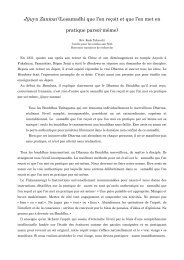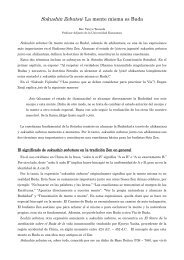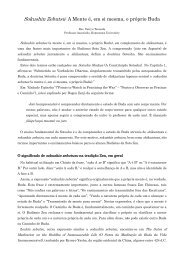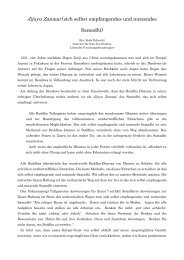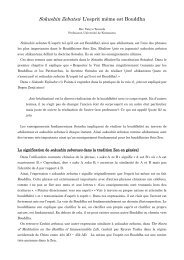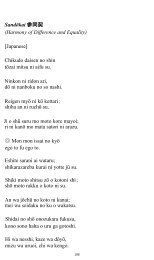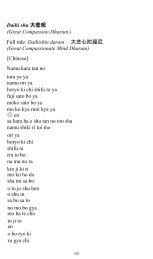Sokushin Zebutsu - sotozen-net
Sokushin Zebutsu - sotozen-net
Sokushin Zebutsu - sotozen-net
You also want an ePaper? Increase the reach of your titles
YUMPU automatically turns print PDFs into web optimized ePapers that Google loves.
with zazen.Dogen Zenji says “<strong>Sokushin</strong> zebutsu is buddhas of aspiration, practice, awakening, andnirvana.”In Shobogenzo “<strong>Sokushin</strong> <strong>Zebutsu</strong>,” Dogen Zenji writes “Upon hearing the phrase ‘sokushinzebutsu,’ ignorant people think that the thoughts and awareness of sentient beings, although theyhave not aroused the aspiration for awakening, are already buddha. They think in this way becausethey have not yet met an authentic teacher.”When ignorant people hear Baso’s well-known phrase, they erroneously think that the ordinarymind of thinking and awareness, the mind before arousing bodhicitta (aspiration for awakening), isunconditionally already Buddha. Dogen admonishes that it is because they have never met anauthentic teacher.Then what is sokushin zebutsu? Dogen writes “<strong>Sokushin</strong> zebutsu is buddhas of aspiration,practice, awakening, and nirvana. Those who have not actualized aspiration, practice, awakening,and nirvana are not sokushin zebutsu.”Usually “aspiration, practice, awakening and nirvana” are thought of as four stages of Buddhisttraining. “Aspiration” is an abbreviation of “aspiration for Bodhi (awakening).” It means to arousethe mind that seeks for the Buddha Way. After aspiration, we move to the stage of practice.“Practice” is an abbreviation of “long-term training with diligence.” As a result of practice, we attainawakening. “Awakening” means to accomplish the Way. With this we enter into nirvana. “Nirvana”means eradication of all defilements. It is a state of attaining complete awakening. There are twokinds of nirvana; nirvana with remainder and nirvana with no residue. Nirvana with remainder isthe nirvana of an awakened person who has eradicated all the defilements but is still alive with abody. Nirvana with no residue is the nirvana of an awakened person who has died and thuseradicated both the body and all defilements. Because of the idea of nirvana with no residue, thedeath of the Buddha is sometimes called nirvana.Therefore, the general understanding of aspiration, practice, awakening, and nirvana is that theyare four sequential stages. Aspiration comes first. After aspiration, practice begins. As a result ofpractice, awakening is accomplished. Then, the awakened person enters the state of nirvana withremainder. When the body dies, the awakened person finally enters nirvana with no residue.However, Dogen Zenji writes in Shobogenzo “Gyoji: Part One” “Between aspiration, practice,awakening and nirvana, there is not a moment’s gap.” There should be no interval or gap betweenthose four. It should be aspirationpracticeawakeningnirvana. Where aspiration is present, there isalready practice. Practice is itself awakening (identity of practice and realization). Thispractice-awakening is nirvana. Thus “aspiration, practice, awakening, and nirvana” are notsequential stages. All are one. Buddhas are practicing this oneness of “aspiration, practice,awakening, and nirvana.” That is exactly what sokushin zebutsu is all about.Shakyamuni Buddha is sokushin zebutsu



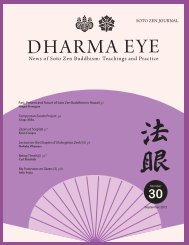

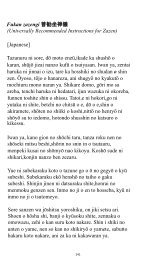

![(Daihishin darani 大æ²å¿éç¾
å°¼ï¼ [Chinese] - sotozen-net](https://img.yumpu.com/38648887/1/156x260/daihishin-darani-aaeaec-3-4-a-1-4-i-1-4-chinese-sotozen-net.jpg?quality=85)


